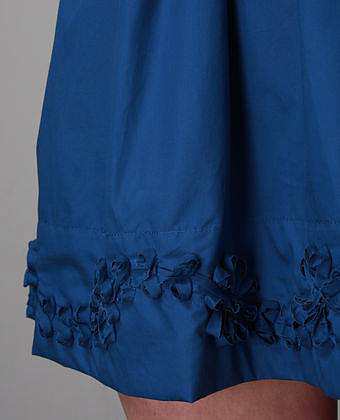I remember growing up with plenty of pretty dresses – some hand-me-downs, a few bought from stores in the small town we lived in, and some sewn by my mother.
Years later, I found myself attempting to learn how to recreate the many beautiful needlework patterns featured on my childhood dresses, patiently guided along by my mother who is a talented needle-worker.
My teenage years were the t-shirt and jeans era, and owning an embroidered piece of clothing was unheard of.
More often than not, my friends would respond with ‘What’s that?’ when I informed them I would be spending the evening on embroidery, smocking, tatting, applique or quilting. (These are forms of needlework which are easy to learn and beautiful to look at, but are intricate and tedious to work on)
For several years, needlework has been the farthest thing from my mind when it comes to clothing and fashion, up till Sunday night.
I attended a student fashion show called ‘Fashion with Passion’, organised by The Students in Free Enterprise (SIFE) from the University of Nottingham, Kuala Lumpur.
Three designers showcased their designs that night. Smocked dresses for children, made by the folks at Persatuan Daybreak (an organization which helps the disabled by providing them with a training ground for learning specialized skills), was up first.
Nostalgia immediately took hold of me as I watched the tiny models strut up and down the catwalk in cute dresses, many of which looked like something I had owned as a child.
It was then that I decided to do some research into intricate decorative needlework, and discovered that its not so ‘old school’ after all.
Lately, it hasn’t been uncommon to find a dress or skirt in a store which has some form of embroidery on it.
In fact, many designers in recent years, have brought intricate needlework to the runway. Just recently, Kenzo’s Spring Summer 2010 collection showcased a variety of designs featuring glittery embroidery, while the Chanel Houte Couture Fall/Winter 2009/2010 collection also featured some beautiful embroidery.
Embroidery is an art form made up of many different stitches, that form all kinds of designs. They adorn everything from necklines to the flair of a dress.
Thread or yarn are used in the craft, and you can also incorporate other materials such as metal strips, pearls, beads, quills, and sequins.
More intricate embroidery is done by hand, although machine embroidery is commonly used in mass-production.A popular use of embroidery comes in the form of cut-out embroidery on necklines and hemlines, usually in floral or leaf designs. Brands like Baby Phat have used this extensively in their collections, and the art is popular in traditional wear like baju kurungs and kebayas.
Applique (a French term meaning applying) is the craft of sewing one piece of fabric to the surface of another. This is commonly used on hemlines and many labels, like Coast, have found a way to work this technique into their collection.
Smocking is made by pulling the cloth into small regular folds held tightly with stitches. Allthough it was used mostly on clothes worn by labourers in England in the 18th and 19th centuries, it has grown in popularity since then.
These days, you can find smocking on blouse necklines, cuffs and is often used at waistlines to add definition to tops and dresses. This method can be found especially on one-size-fits-all sort of dresses, as the stretch provided by the smocking makes them suitable for most body shapes.
You don’t have to look very far to find apparel which features needlework of this sort, and you certainly don’t have to pay through your nose for designer wear. Somerset Bay is one place you can go to drown yourself in embroidery, smocking and all kinds of intricate needlework.



Tell us what you think!